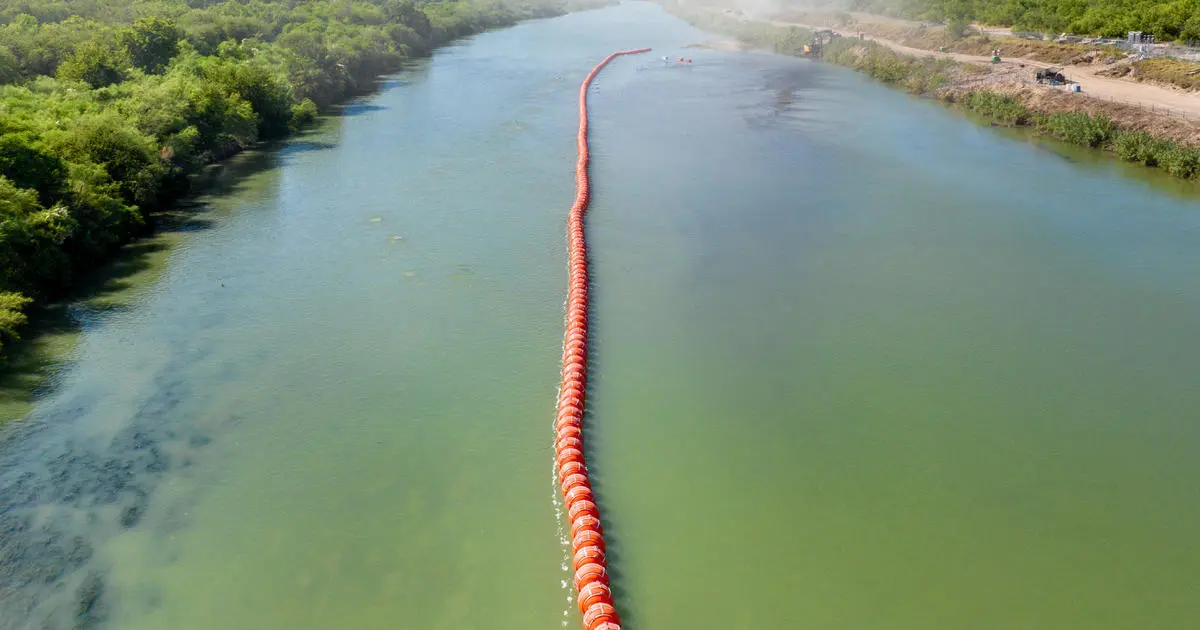Ezra found that Texas’ buoys obstructed free navigation in the Rio Grande
Navigable servitude. Article I Section 8 of the Constitution grants the Federal Government ultimate control of navigable waters.
It was one of the arguments in the original filing that I had a suspicion that the courts would favor on enforcing. Part of the Rio Grande that has some the floats isn’t exactly used for boat traffic so it was interesting to see the Court give the entire waterway to the US government.
That all said, with this injunction this quickly for this reason, Texas’ floating barrier is pretty dead, never to return. Even the textualist of the SCOTUS will have a hard time trying to bend backwards on the Constitution explicitly indicating that the various rivers of this country belong to the US government first and foremost.
Part of the Rio Grande that has some the floats isn’t exactly used for boat traffic so it was interesting to see the Court give the entire waterway to the US government.
The court didn’t “give the entire waterway to the US government.” The judge enforced long-standing rules.
From Federal regulations:
§ 329.4 General definition.
Navigable waters of the United States are those waters that are subject to the ebb and flow of the tide and/or are presently used, or have been used in the past, or may be susceptible for use to transport interstate or foreign commerce. A determination of navigability, once made, applies laterally over the entire surface of the waterbody, and is not extinguished by later actions or events which impede or destroy navigable capacity.
§ 329.5 General scope of determination.
The several factors which must be examined when making a determination whether a waterbody is a navigable water of the United States are discussed in detail below. Generally, the following conditions must be satisfied:
(a) Past, present, or potential presence of interstate or foreign commerce;
(b) Physical capabilities for use by commerce as in paragraph (a) of this section; and
© Defined geographic limits of the waterbody.
The Supreme Court recently reduced the EPA’s authority over water and wetlands. It’s not entirely unthinkable that this could be used to further restrict navigable waters, to those that are used or reasonably could be used.
I hope a Nazi is maimed by the rusty saw blades they put between the buoys to harm immigrants.
“This ruling is incorrect and will be overturned on appeal.”
Care to wager on that?
This is the best summary I could come up with:
A federal judge in Austin on Wednesday ordered Texas to remove river barriers that the state assembled along a stretch of the U.S.-Mexico border to repel migrants, giving the Biden administration an early victory in its lawsuit against the buoys approved by Republican Gov.
Senior U.S. District Court Judge David Ezra issued a preliminary injunction directing Texas officials to remove the floating border barriers from the middle of the Rio Grande by Sept. 15, at the state’s own expense.
The Biden administration filed its lawsuit against the floating barriers in late July, arguing that Texas needed permission from the federal government to set up the buoys, and that the state had failed to acquire it.
Last month, Texas repositioned the buoys closer to American soil after federal officials disclosed a joint U.S.-Mexico survey that concluded that roughly 80% of the barriers had been set up in Mexican territory.
The legal fight over the buoys has become the latest flash point in a two-year political feud between the Biden administration and Abbott, who has accused the federal government of not doing enough to deter migrants from crossing the southern border illegally.
The most high-profile component of Abbott’s operation has been an effort to bus thousands of migrants from the southern border to large Democratic-led cities like New York, Chicago and Denver, which now find themselves struggling to house destitute newcomers who lack ties to the U.S.
The original article contains 596 words, the summary contains 235 words. Saved 61%. I’m a bot and I’m open source!
This is the best summary I could come up with:
A federal judge in Austin on Wednesday ordered Texas to remove river barriers that the state assembled along a stretch of the U.S.-Mexico border to repel migrants, giving the Biden administration an early victory in its lawsuit against the buoys approved by Republican Gov.
Senior U.S. District Court Judge David Ezra issued a preliminary injunction directing Texas officials to remove the floating border barriers from the middle of the Rio Grande by Sept. 15, at the state’s own expense.
The Biden administration filed its lawsuit against the floating barriers in late July, arguing that Texas needed permission from the federal government to set up the buoys, and that the state had failed to acquire it.
Last month, Texas repositioned the buoys closer to American soil after federal officials disclosed a joint U.S.-Mexico survey that concluded that roughly 80% of the barriers had been set up in Mexican territory.
The legal fight over the buoys has become the latest flash point in a two-year political feud between the Biden administration and Abbott, who has accused the federal government of not doing enough to deter migrants from crossing the southern border illegally.
The most high-profile component of Abbott’s operation has been an effort to bus thousands of migrants from the southern border to large Democratic-led cities like New York, Chicago and Denver, which now find themselves struggling to house destitute newcomers who lack ties to the U.S.
The original article contains 596 words, the summary contains 235 words. Saved 61%. I’m a bot and I’m open source!




